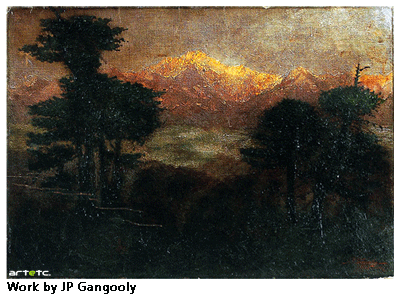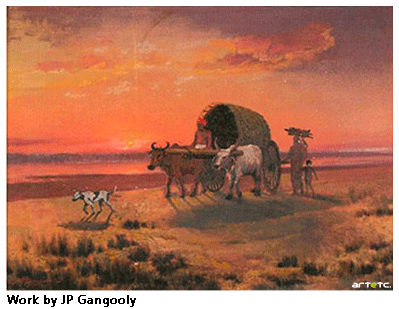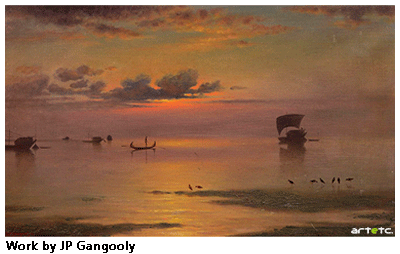- Publisher's Note
- Editorial
- Jogen Chowdhury: Maestro par Excellence
- Company School Paintings of Calcutta, Murshidabad, Patna (1750-1850): Doctoral Thesis of Late Dipak Bhattacharya (1960-2007)
- Kalighat Pat, a Protomodern Art Tradition?
- Academic Naturalism in Art of Bengal: The First Phase of Modernity
- Under the Banyan Tree - The Woodcut Prints of 19th Century Calcutta
- The Arabian Nights and the Web of Stories
- Gaganendranath Tagore's Satirical Drawings and Caricatures
- Gaganendranath's Moments with Cubism: Anxiety of Influence
- Abanindranath as Teacher: Many Moods, Some Recollections
- Atul Bose: A Short Evaluation
- J.P. Gangooly: Landscapes on Canvas
- Defined by Absence: Hemen Majumdar's Women
- Indra Dugar: A Profile of a Painter
- The Discreet Charm of Fluid Lines!
- Delightful Dots and Dazzling Environments: Kusama's Obsessive Neurosis
- Peaceful be Your Return O Lovely Bird, from Warm Lands Back to My Window
- Shunya: A Beginning from a Point of Neutrality
- The Tagore Phenomenon, Revisited
- The Bowl, Flat and Dynamic Architecture of the BMW Museum
- Baccarat Paperweights: Handmade to Perfection
- Byzantium and Islam: Age of Transition at the Metropolitan Museum of Art
- Outstanding Egyptian Art at the Metropolitan Museum of Art
- Retrospective of Wu Guanzhong at the Asia Society Museum
- Masterpieces from India's Late Mughal Period at the Asia Society Museum
- The Dhaka Art Summit: Emergence of Experimental Art Forms
- Many Moods of Eberhard Havekost
- Random Strokes
- Is it Putin or the Whole Russian State?
- The Onus Lies With Young India
- What Happened and What's Forthcoming
- Preview May, 2012 – June, 2012
- In the News, May 2012
- Art Events Kolkata, April – May 2012
- Mumbai Art Sighting
- Delhi Dias
- Art Bengaluru
- Musings from Chennai
- Cover
ART news & views
J.P. Gangooly: Landscapes on Canvas
Issue No: 29 Month: 6 Year: 2012
by Anurima Das
 Art knows no boundaries and so should the artists. In the community of the 'patuas' or scroll painters of Bengal, one may find the perfect manifestation of that spirit. They are a community of both Hindus and Muslims by birth, but follow a common religion of art painting and modelling images of Hindu Gods and Goddesses.
Art knows no boundaries and so should the artists. In the community of the 'patuas' or scroll painters of Bengal, one may find the perfect manifestation of that spirit. They are a community of both Hindus and Muslims by birth, but follow a common religion of art painting and modelling images of Hindu Gods and Goddesses.
The 'patuas' dominated the native villages of Bengal during the Middle Ages and practiced a distinct traditional style of painting on cloth. The journey of the 'patuas' from their native village to the city of Kolkata, during the 19th century etches out a distinct painting tradition in the history of Bengal. The devastations and the loss of village life pushed the rural painters to take rescue at Kolkata and they started painting Gods and Goddesses on cheap paper instead of cloth. Unable to sustain an income they began selling these paintings to pilgrims and devotees visiting the Kalighat temple. But it was too soon that the subject of the paintings started bearing an urban flavour. While, the 'Kalighat patachitra' still finds a prominent mention in the art history tradition of Bengal. But it was towards the middle of the 19th Century that the idea of painting got revived under the canvas of Jamini Prakash Gangopadhyay (better known as J.P. Gangooly).
The artist in question practiced his art form during the period of late 19th century to the early 20th century. But his works have remained buried by the dominance of the neo nationalist and modern revivalist art movements of that period. But J.P.Gangooly practiced oil on canvas and simply reinvented the idea of landscape painting. The concept of light and shade and the notion of space in his paintings found a new dimension as compared to the other modernist paintings of the same period. Unlike the other prominent painters of that time J.P. Gangooly's work clearly bore evidence to a western naturalistic tendency. Even though he worked with several genres and practiced a variety of paintings but it was the landscapes and portraits that he excelled in. Mountain ranges, rivers and the rural landscapes have always dominated his oil canvases and painting the natural scenes at various times of the day was the painter's favourite. Capturing the sunrise and sunset and thereby painting canvases at varied light exposures was what J.P.Gangooly excelled in.
 Born in the year 1876, the artist had his first stint with colours and canvas at his Jorasanko home. Being the nephew of Rabindranath Tagore proved helpful for Gangooly as, he got introduced to painting and Western education at home and was home tutored for quite a long time. He remained a student of young Abanindranath Tagore and much like the affluent artists of the period he was taught by British painter CL Palmer. His stylistic abilities and his idea of oil painting was a result of the upbringing he had within the Thakurbari premises and the Western connections he nurtured through his Painting teacher. The western naturalistic style always intrigued and influenced Gangooly and it was during his tenure at the Calcutta Government Art School. It was this association that helped the artist attain that firm grip over his liking and thereby made him more focused in his ways. He has always used oil colours as the medium of his paintings and thereby has produced charming, naturalist landscapes like that of the Himalayas at the Sunset or Sunrise or the Padma River at Dawn. His associations with the Calcutta Government Art School became stronger when he was actually shouldered the responsibility of running the college as its Vice-Principal. After Abanindranath decided to leave the college, the entire responsibility was on Gangooly's shoulder. And he had to even work on commissioned oil paintings that the Principal of the college Mr. Percy Brown brought his way.
Born in the year 1876, the artist had his first stint with colours and canvas at his Jorasanko home. Being the nephew of Rabindranath Tagore proved helpful for Gangooly as, he got introduced to painting and Western education at home and was home tutored for quite a long time. He remained a student of young Abanindranath Tagore and much like the affluent artists of the period he was taught by British painter CL Palmer. His stylistic abilities and his idea of oil painting was a result of the upbringing he had within the Thakurbari premises and the Western connections he nurtured through his Painting teacher. The western naturalistic style always intrigued and influenced Gangooly and it was during his tenure at the Calcutta Government Art School. It was this association that helped the artist attain that firm grip over his liking and thereby made him more focused in his ways. He has always used oil colours as the medium of his paintings and thereby has produced charming, naturalist landscapes like that of the Himalayas at the Sunset or Sunrise or the Padma River at Dawn. His associations with the Calcutta Government Art School became stronger when he was actually shouldered the responsibility of running the college as its Vice-Principal. After Abanindranath decided to leave the college, the entire responsibility was on Gangooly's shoulder. And he had to even work on commissioned oil paintings that the Principal of the college Mr. Percy Brown brought his way.
Guiding the students with their assigned works was a part of Gangooly's daily routine and he even instructed and taught them watercolour even though he himself was not so fluent with the medium. Teaching his students righteously and helping them understand painting and colours better was a duty for the artist. He completely discouraged the use of artificial colours and was keener on making use of handmade pigments. His works on canvas reflects the natural in the way it is and essentially brings out the real flavour of existence. Tranquility prevails through his painting ushering peace and comfort.
 Apart from the most famous landscape paintings and portraiture, Gangooly also painted religious themes on canvas. Few of his most remarkable works on this theme borrowed from the Indian Epics are Raja Shudraker Sabhay Shuka-Shari, Buddher Grihatyag, Shri Krishner Yugal Rupa, Pujarini, Birahi Yaksa, Sandhya Aradhana. Colour played a very important role in all his works and he loved working with tones of yellow, blue and red. Working with hues of these colours and bringing alive each shade through his canvas to bring alive a rhythm, was what came naturally to the artist. His paintings presented the Himalayas in a very distinct manner. It was the snow capped mountain peaks, which took the centre stage in his paintings. He worked with the same mountain ranges but tried inducing the rugged flavour of the Mountainous region with the tender affection of the snow capped peaks. The tenderness of the snow capped mountain ranges at midnight varied from the stylistic beauty of the same at noon or even when the first ray of sun fell on them. Gangooly knew the variations and has worked quite carefully with oil colours to bring those serene yet appealing flavours out on the canvas. His paintings were a regular attribute in famous journals like Pradip, Bharati, Prabashi, Victorian India, Modern Review, Bharat Bharsho, Sachitra Shishir, Masik Basumati and journals of Academy of Fine Arts and Visva Bharati.
Apart from the most famous landscape paintings and portraiture, Gangooly also painted religious themes on canvas. Few of his most remarkable works on this theme borrowed from the Indian Epics are Raja Shudraker Sabhay Shuka-Shari, Buddher Grihatyag, Shri Krishner Yugal Rupa, Pujarini, Birahi Yaksa, Sandhya Aradhana. Colour played a very important role in all his works and he loved working with tones of yellow, blue and red. Working with hues of these colours and bringing alive each shade through his canvas to bring alive a rhythm, was what came naturally to the artist. His paintings presented the Himalayas in a very distinct manner. It was the snow capped mountain peaks, which took the centre stage in his paintings. He worked with the same mountain ranges but tried inducing the rugged flavour of the Mountainous region with the tender affection of the snow capped peaks. The tenderness of the snow capped mountain ranges at midnight varied from the stylistic beauty of the same at noon or even when the first ray of sun fell on them. Gangooly knew the variations and has worked quite carefully with oil colours to bring those serene yet appealing flavours out on the canvas. His paintings were a regular attribute in famous journals like Pradip, Bharati, Prabashi, Victorian India, Modern Review, Bharat Bharsho, Sachitra Shishir, Masik Basumati and journals of Academy of Fine Arts and Visva Bharati.
After his early home tutoring years, Gangooly also got himself enrolled at the City Collegiate School and later at the Metropolitan Institution at Calcutta. The artist possessed invincible skills in working with the oil medium and practiced a consummate oil applicability technique. His ideas of shifting gradations and variations of light came out quite clearly in his canvases and his mastery over the oil medium still remains a benchmark for the Indian painters. His abilities and skills not just became prominent through his nature paintings but also through the transience of the human face, captured in relation to changing light.
All through his career the artist has been justly awarded and honoured for his brilliant painting style and the grandeur he brought out through his oil canvases. In the year 1902 he was awarded the Simla Art Society award at Simla, and received an award at the Bombay Art Society Exhibition in the same year. Apart from that he was also felicitated with a Gold Medal in 1910 at the Bombay Art Society along with the title Cavalier to the Crown by Victor Immanuel also known as 'William Turner' of India. He had also received an award at the Indian Society of Oriental Art, Calcutta in 1908. The award was procured to him just a year after he had laid the foundation for the Indian Society of Oriental Art, Calcutta.
Gangooly did not only excel with his paintings but was also a man of discipline. His efforts and skills were not only restricted towards his oil paintings but was also extended to his administrative duties. In 1905 he was elected the joint chair person of the Bangiya Kala Samsad, Calcutta who later went on to become the father of the Oriental Art, Calcutta. In 1936 he was also elected as the joint director of the Academy of Fine Arts, Calcutta. The artist began his endeavor by working on mythical paintings and also tried his hands with portraiture. But it was soon that he discovered his true talents lies with landscape painting and thereby he began relating himself with the nature. The rivers, bathing ghats, paddy fields, fishing boats etc drew his attention and entangled him within a bond. His observation of these mundane places during sunset and sunrise resulted into the extravagant oils. It was his extensive training that gave birth to the professional yet distinguished artist J.P.Gangooly. The great artist declined to slumber forever in the year 1953 leaving behind his serene oil paintings. It was his work made on coarse Jute cloth, that attained him fame even in the last years of his life. The painting was titled Ulka.
The Jorasanko connect and his early teachings from renowned and prominent teachers paved the way for J.P. Gangooly to nurture himself as a painter. But it was essentially his unique understanding of the landscapes and his abilities to decipher the essence of the same that brought out the real painter in him. He over the years developed a bond with the Himalayas and the village landscapes which indeed helped him paint his canvas and represent the nature in its real essence with her own naturalistic tendencies. But apart from the mountains what attracted him more was the river Padma. He, all through his lifetime, had painted nearly a hundred oil paintings of the sun setting on the river Padma for which he was ultimately given the name of 'Painter of Padma'. His oils still speak the language of grandeur and can adorn walls of the affluent homes much like in the times of the Zamindars.